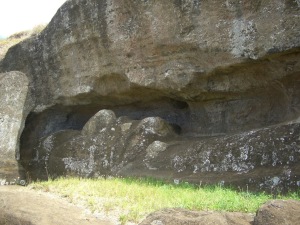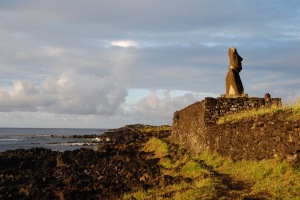
Moai are really tomb monuments destined for an ahu or pedestal on the shores of Easter Island. They weigh hundreds of tons so moving them from the quarry in an extinct volcano called Rano Raraku was complicated with no concept of wheels. Ahu are crematories where ashes of royalty mixed with volcanic ash. The only means of moving them was by the shoulders, since the body is a huge block. Reminded me of the penguin walk, wobbling side to side with no arms. A few Moai have a series of long lines carved on the sides – indicating delicate hands and fingers, a sign that this Moai was for a king, who never worked with his hands. The men were either called long eared or short eared, the long eared being the authority and royalty, the short eared being the workers. What saddened me was seeing how the Moai were so heavy and awkward they often fell over, their noses flat on the ground abandoned to the lichens, the toki rau or wind and the elements, never to stand prideful where they were destined. Tradition attributes the concept of “mana” or a holy spirit as having presence in the Moai of famous leaders.
I hiked to the crater with two young ladies, Andrea and Adriana, and our guide was Nico, who is as indigenous as anyone could be on this island, and knows his history. His passion is to protect that from mis-interpretation and the erosion of human hands and seats. No one touches with finger, hand, foot or seat neither the Moai nor the volcanic constructions where the ancients lived and worked. The order for the day was Don’t Touch the Volcanic Rocks. And yet, this island of 15,000 residents and 600 Moai swarms with disrespectful tourists who sit on a large boulder without realizing it is part of the severed body of a Moai.
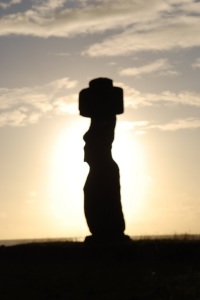
Photo: My favorite Moai with a cross for his hat.
We walked through fields of volcanic rock arranged in round circles called hare mon or chicken houses. Chickens went into darkened rock interiors to spend the night, but laid their eggs outside. There were boat houses called hari vaca where the black rock was lined up on the ground as if my granddaughter was building a house with wooden blocks. These rocks were called pie nga (I believe there was another meaning which I didn’t get that caused everyone to laugh) and were used as well for the Kings quarters. Understand, the walls, long disappeared, were made of sticks and grasses. So all that remains are the rocks that marked the borders of the sleeping quarters. But the legends, as that of Rey Tu’u cohigu, are still alive today as we strolled through his domain overlooking the Pacific Ocean. Most moving was the black lava cave where the people would hide for years from pirates and traders seeking slaves. It was invisible from the sea. Nico also showed us that the Easter Island people never slept like we do on beds, but folded up in a squat, feet firmly planted, arms wrapped around knees and slept lined up, shoulder to shoulder, so to speak, hundreds together. Looked unbearable to me since I can’t even squat on folded knees.
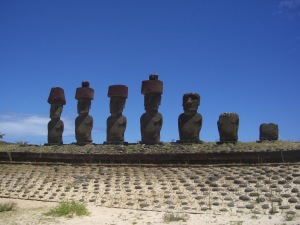
Photo: Seven Moais in a row (restored).
The Moai don’t face the sea but if these statues were placed on their destinations, the ahu, then they face away from the sea toward the land and the people in order to watch over them. Nico gave a good comparison: when you enter the church, the first thing you see is Christ high up on the cross looking toward the congregation, toward his people and protecting them. This is also the task of the Moai. To Protect. Since the Chilean invaders claimed this island a century ago, it has become primarily Catholic, eliminating any signs of the old beliefs and mysteries just as the pure blood of the Easter Island people has been watered down by Chileans and other foreigners who came here for one reason or another. At one point there were no animals on this island, now it’s inundated with dogs, rats, cows, horses. At one time there were no palm trees or bouganvilla or hibiscus or El Ciebo or Eucalyptus trees, but they now occupy like weeds, having killed the indigenous plants that once fed this island. It breaks your heart that so much has been loss in the effort to settle here. 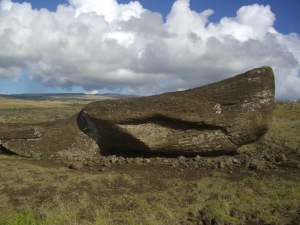 A Fallen Moai
A Fallen Moai
Easter Island is a triangle of mystery. Moai draw you to them, whether they are on the eastern side where you watch the sun rise or the western side where you watch the sun set, always with a line of Moai for good photographs. The residents of Easter Island depend on fishing, on planting (pineapples are major here) and tourism. The horses, nondescript breeds and used for transport and competitions, are dying of a incurable disease that causes tumors in their esophagus so they starve to death. Many will be happy to see them go. Once there were thousands all over the island – and there is still invasive horse poop in the paths we hike. Although there were plenty of newborn colts and fillies, the mood is that of decline. In the period 1900 through 1953 the British rented Easter Island as a sheep farm. They paid the Chilean government for the right and at one time had 100 million sheep on this precious island. When their time was up, and they had made fortunes on the wool and lamb meat, they slaughtered what was left and departed.
At the end of the long hike, we were taken to Playa Anakena, an immaculately white beach in front of a restored Moai fronting the most incredible sapphire blue sea. A dip in the bay was much warmer than the Antarctic sea, and the water was so transparent I could see pale blue 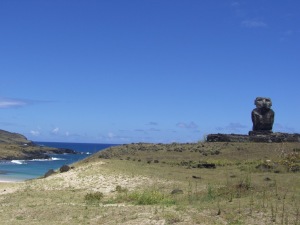 fish sucking the sand for food. They are called maito and kotea. I was reluctant to cross in front of a long thin fish which looked like a crystal blue serpent that kept only slightly in front of me as I got closer. (He was in my exit path.) There is beauty under water here, as well as above surf where enormous swells of waves knock against the black volcanic rocks. Explora prepared a picnic under the umbrella of flowering El Ciebo trees, that included fresh squeezed guava juice (sigh), raw tuna caught in these very waters, tuna cerviche , kumara (sweet potatoes) and po’e, a moist banana cake wrapped in banana leaves. We then were driven to the other side of the island to walk through the domain of a king. There, I ran into my group from the Endeavor, who were, not knowing, sitting on rocks that were not to be touched. Alas, Nico politely corrected them.
fish sucking the sand for food. They are called maito and kotea. I was reluctant to cross in front of a long thin fish which looked like a crystal blue serpent that kept only slightly in front of me as I got closer. (He was in my exit path.) There is beauty under water here, as well as above surf where enormous swells of waves knock against the black volcanic rocks. Explora prepared a picnic under the umbrella of flowering El Ciebo trees, that included fresh squeezed guava juice (sigh), raw tuna caught in these very waters, tuna cerviche , kumara (sweet potatoes) and po’e, a moist banana cake wrapped in banana leaves. We then were driven to the other side of the island to walk through the domain of a king. There, I ran into my group from the Endeavor, who were, not knowing, sitting on rocks that were not to be touched. Alas, Nico politely corrected them. 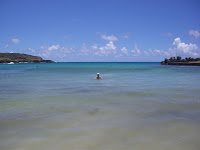
Although the day was long, we still went to Ahu Tahai near the city of Rapa Nui to watch the sun’s departure for this exciting day. There are five restored Moai lining the beach and high by itself is the Moai I fancy the most – it’s the only one on the island which has eyes, eerie marble eyes, and his hat or crown gives the image of a cross against the amorphic cloudy blue skies. We sat in chairs with holders for drinks – mine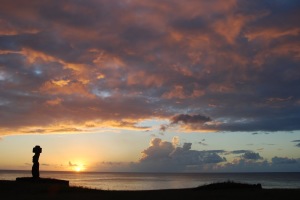 was mango juice with lemon – and Nico brought his uncle to talk with us. We learned much about the toughness of life on the island, and when asked which was his favorite Moai, he said the one in front of his house. He had carved his own Moai, put it in front of his house with it facing the house to give him protection, which it always has. He insisted the spirit of the Moai still permeates the spirit of the Rapa Nui living on Easter Island today. I could believe it.
was mango juice with lemon – and Nico brought his uncle to talk with us. We learned much about the toughness of life on the island, and when asked which was his favorite Moai, he said the one in front of his house. He had carved his own Moai, put it in front of his house with it facing the house to give him protection, which it always has. He insisted the spirit of the Moai still permeates the spirit of the Rapa Nui living on Easter Island today. I could believe it.
[Link: Map of Easter Island.]

